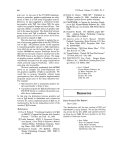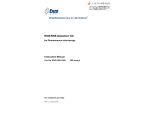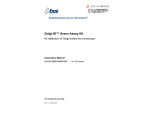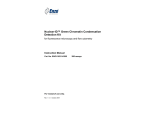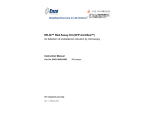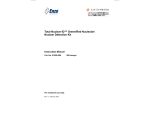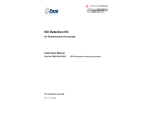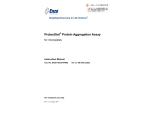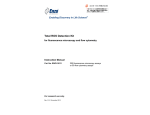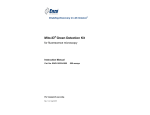Download ENZ-51002 User Manual- Rev 1.1.1 20090818.pub
Transcript
※本プロトコールは参考用の資料になり ます。商品ご購入の際は必ず商品に添付 されている資料をご参照ください。 GFP-Certified™ Apoptosis/Necrosis Detection Kit for microscopy and flow cytometry Instruction Manual Cat. No. ENZ-51002-100 100 Reactions Cat. No. ENZ-51002-25 25 Reactions For research use only. Rev. 1.1.1 August 2009 Notice to Purchaser This product is manufactured and sold by ENZO LIFE SCIENCES, INC. for research use only by the end-user in the research market and is not intended for diagnostic or therapeutic use. Purchase does not include any right or license to use, develop or otherwise exploit this product commercially. Any commercial use, development or exploitation of this product or development using this product without the express prior written authorization of ENZO LIFE SCIENCES, INC. is strictly prohibited. Limited Warranty These products are offered under a limited warranty. The products are guaranteed to meet appropriate specifications described in the package insert at the time of shipment. Enzo Life Sciences’ sole obligation is to replace the product to the extent of the purchase price. All claims must be made to Enzo Life Sciences, Inc. within five (5) days of receipt of order. Trademarks and Patents Enzo and GFP-Certified are trademarks of Enzo Life Sciences, Inc. Several of Enzo’s products and product applications are covered by US and foreign patents and patents pending. Contents I. Introduction ............................................................... 1 II. Reagents Provided and Storage.............................. 2 III. Additional Materials Required ................................. 2 IV. Safety Warnings and Precautions........................... 2 V. Methods and Procedures ......................................... 3 A. REAGENT PREPARATION ........................................... 3 B. DUAL DETECTION REAGENT PREPARATION ........... 3 C. FLOW CYTOMETRY PROTOCOL (Non-Adherent Cells)...................................................... 4 D. FLOW CYTOMETRY PROTOCOL (Adherent Cells) ............................................................. 5 E. WIDE FIELD FLUORESCENCE / CONFOCAL MICROSCOPY PROTOCOL .......................................... 6 VI. Appendices ............................................................... 6 A. FILTER SET SELECTION ............................................ 6 B. CELL FIXATION ........................................................... 6 C. RESULTS ..................................................................... 7 VII. References ................................................................ 7 VIII. Troubleshooting Guide ........................................... 9 I. Introduction The transition from apoptosis to necrosis is a loosely defined continuum that necessitates recognition of the various stages of the process. The display of phosphatidylserine (PS) on the extracellular face of the plasma membrane remains a unifying hallmark of early apoptosis. Phospholipid-binding proteins such as Annexin V bind with a high affinity to PS, in the presence of Ca2+. Given that Annexin V is not cell permeable, the binding of externalized PS is selective for early apoptotic cells. Similarly, loss of plasma membrane integrity, as demonstrated by the ability of a membrane-impermeable DNA intercalating dye to label the nucleus, represents a straightforward approach to demonstrate late stage apoptosis and necrosis. Considering that Annexin V is commonly conjugated to fluorescein (a.k.a. FITC), apoptosis detection in green fluorescent protein (GFP)expressing cells can be problematic. The spectral overlap between the emission profiles of these two fluorophores makes differentiation between signals difficult or impossible, thus compromising data quality overall. While useful for analysis of apoptosis and necrosis in cells that do not express any fluorescent proteins, the GFP-Certified™ Apoptosis/Necrosis Detection Kit was specifically designed for use with GFP-expressing cell lines and cells expressing blue or cyan fluorescent proteins (BFPs, CFPs). Additionally, the kit is suitable for use with live or post-fixed cells in conjunction with probes, such as labeled antibodies, or other fluorescent conjugates displaying similar spectral properties as fluorescein or coumarin. Each GFP-Certified™ Apoptosis/Necrosis Detection Kit includes all the necessary reagents for determination of early and late stages of apoptosis as well as necrosis. An Annexin V-EnzoGold (enhanced Cyanine -3) conjugate enables detection of apoptosis distinct from fluorescein or GFP. The Necrosis Detection Reagent (Red) similar to the redemitting dye 7-AAD, facilitates late apoptosis and necrosis detection. This kit also includes an Apoptosis Inducer (Staurosporine) for use as a positive control. Detection reagents can be used separately or in combination for either single or multiplexed applications respectively. This kit also provides quick and accurate results via flow cytometry and fluorescence/confocal microscopy. 1 II. Reagents Provided and Storage All reagents are shipped on wet ice. Upon receipt, store all reagents at 4°C, protected from light. The reconstituted Apoptosis Inducer should be stored at –20°C. Reagent 100 Reactions 25 Reactions Apoptosis Detection Reagent (Annexin V-EnzoGold) 550 µL 140 µL Necrosis Detection Reagent (Red) 600 µL 150 µL Apoptosis Inducer (Staurosporine) 50 nmoles 50 nmoles 6 mL 1.5 mL Binding Buffer (10X) III. Additional Materials Required Standard fluorescence microscope or a flow cytometer that is equipped with a 488 nm laser for fluorescent dye excitation Phosphate buffered saline (PBS) Calibrated, adjustable precision pipetters, preferably with disposable plastic tips 5 ml tubes appropriate for holding cells during induction of apoptosis and necrosis Adjustable speed centrifuge with swinging buckets Glass microscope slides (for microscope analysis only) Glass cover slips (for microscope analysis only) Deionized water Anhydrous DMSO IV. Safety Warnings and Precautions This product is for research use only and is not intended for diagnostic purposes. Some components of this kit contain hazardous substances. Reagents can be harmful if ingested or absorbed through the skin and may cause irritation to the eyes. Reagents should be treated as possible mutagens and should be handled with care and disposed of properly. Observe good laboratory practices. Gloves, lab coat, and protective eyewear should always be worn. Never pipet by mouth. Do not eat, drink or smoke in the laboratory areas. All blood components and biological materials should be treated as potentially hazardous and handled as such. They should be disposed of in accordance with established safety procedures. To avoid photobleaching, perform all manipulations in low light environments, in amber microcentrifuge tubes or protected from light by other means. 2 V. Methods and Procedures A. REAGENT PREPARATION 1. Positive Control The Apoptosis Inducer (Staurosporine) is supplied as a lyophilized powder (50 nmoles) and should be reconstituted in 50 L DMSO for a 1 mM stock solution. It is recommended that induction occur at the effective concentration (EC50) and that the final percent DMSO in the assay not exceed 0.2%. 2. Cell Preparation Cells should be maintained via standard tissue culture practices. Positive Control cells should be pretreated with the Apoptosis Inducer for 1-16 hours. Induction of apoptosis and necrosis is time and concentration dependent and may also vary significantly depending among cell types and cell lines. Post treatment cells should be harvested and diluted to a working concentration of 2.0x105/mL in media. Negative control cells should be treated with vehicle (DMSO, media or other solvent used to reconstitute or dilute an inducer or inhibitor) for an equal length of time under similar conditions. 3. 1X Binding Buffer Generate 500 L of 1X Binding Buffer per sample by diluting 50 L of 10X Binding Buffer into 450 L of deionized water. Batch preparation is recommended for large numbers of samples. B. DUAL DETECTION REAGENT PREPARATION Prepare the Dual Detection Reagent according to Table 1. The volumes recommended in the table are sufficient for one assay and must be scaled accordingly. Table 1. Dual Detection Reagent Reagent Amount 500 µL 1X Binding Buffer Apoptosis Detection Reagent (Annexin V-EnzoGold) 5 µL Necrosis Detection Reagent (Red) 5 µL Total Volume 3 510 µL C. FLOW CYTOMETRY PROTOCOL (Non-Adherent Cells) 1. The recommended sample size should be between 2 x 105 cells/ sample and 1 x 106 cells/sample during staining and analysis. 2. Treat cells with compound of interest and Negative Control cells with vehicle. 3. Centrifuge cells for 5 minutes at 400 x g at room temperature (RT). 4. Carefully remove supernatant by aspiration and gently resuspend and wash the pellet in 5.0 mL cold PBS. 5. Centrifuge cells for 5 minutes at 400 x g at room temperature (RT). 6. Carefully remove supernatant and gently resuspend the pellet in 500 L Dual Detection Reagent. (see Table 1 on section B. p3) 7. Protect samples form light and incubate for 15 minutes at room temperature. 8. Samples should be analyzed via flow cytometry using a 488 nm laser with the FL 1 channel for GFP or FITC detection, the FL 2 channel for the Apoptosis Detection Reagent and the FL 3 channel for the Necrosis Detection Reagent. It is recommended that compensation corrections be performed using single stained induced cells to avoid any overlap between the Apoptosis Detection Reagent and Necrosis Detection Reagent (Red) fluorescent signals. 9. Positive Control Samples: It is recommended that positive control samples be pretreated with the Apoptosis Inducer (Staurosporine) at a final concentration of 2 M for 4 hours. Apoptosis may vary significantly and is dependent upon the length of induction, inducer concentration, cell types, cell lines, inducer concentration and exposure time. Follow steps 2-8 post treatment. Suggested Compensation Controls for Flow Cytometry: a. Unstained cells b. Cells stained with Apoptosis Detection Reagent (without Necrosis Detection Reagent) c. Cells Stained with Necrosis Detection Reagent (without Apoptosis Detection Reagent) Note: Samples and controls should be kept on ice before the assay is run and analyzed via flow cytometry within one hour of staining. 4 D. FLOW CYTOMETRY PROTOCOL (Adherent Cells) 1. The recommended sample size should be between 2 x 105 cells/ sample and 1 x 106 cells/sample during staining and analysis. 2. Treat cells with compound of interest and Negative Control cells with vehicle. 3. Detach cells via trypsinization or other cell dissociation method. Minimize cellular damage by optimizing the concentration and time cells are exposed to Trypsin. 4. Centrifuge cells for 5 minutes at 400 x g at room temperature (RT). 5. Carefully remove supernatant by aspiration and gently resuspend and wash the pellet in 5.0 mL cold PBS. 6. Centrifuge cells for 5 minutes at 400 x g at room temperature (RT). 7. Carefully remove supernatant and gently resuspend the pellet in 500 L Dual Detection Reagent (see Table 1 on page 3). 8. Protect samples form light and incubate for 15 minutes at room temperature. 9. Samples should be analyzed via flow cytometry using a 488 nm laser with the FL 1 channel for GFP or FITC detection, the FL 2 channel for the Apoptosis Detection Reagent and the FL 3 channel for the Necrosis Detection Reagent. It is recommended that compensation corrections be performed using single stained induced cells to avoid any overlap between the Apoptosis Detection Reagent and Necrosis Detection Reagent fluorescent signals. 10. Positive Control Samples: It is recommended that positive control samples be pretreated with the Apoptosis Inducer at a final concentration of 2 M for 4 hours. Apoptosis may vary significantly and is dependent upon the length of induction, inducer concentration, cell types, cell lines, inducer concentration and exposure time. Follow steps 2-9 post treatment. Suggested Compensation Controls for Flow Cytometry: a. Unstained cells b. Cells stained with Apoptosis Detection Reagent (without Necrosis Detection Reagent) c. Cells Stained with Necrosis Detection Reagent (without Apoptosis Detection Reagent) Note: Samples and controls should be kept on ice before the assay is run and analyzed via flow cytometry within one hour of staining. 5 E. WIDE FIELD FLUORESCENCE/CONFOCAL MICROSCOPY 1. Grow cells directly onto glass slides or polystyrene tissue culture plates until ~80% confluent. 2. Treat cells with compound of interest and Negative Control cells with vehicle. 3. Carefully wash cells twice with 1x PBS in a volume sufficient for covering the cell monolayer. 4. Carefully remove supernatant and dispense the Dual Detection Reagent in a volume sufficient for covering the cell monolayer (as per section B) 5. Protect samples from light and incubate for 15 minutes at room temperature. 6. Flick the staining solution onto a paper towel and if necessary add a few drops of Binding Buffer to prevent the cells for drying out. 7. Cover cells and observe under a fluorescence/confocal microscope with a dual filter set for Cyanine-3 (Ex/Em: 550/570 nm) and 7-AAD (Ex/Em: 546/647 nm) and a GFP/FITC (Ex/Em: 488/514 nm) filter should be used if either is imaged simultaneously. 8. Positive Control Samples: It is recommended that Positive Control samples be pretreated with the Apoptosis Inducer at a final concentration of 2 M for 4 hours and may vary significantly among cell types and cell lines. Follow steps 3-7 post treatment. VI. APPENDICES A. FILTER SELECTION The selection of optimal filter sets for a fluorescence microscopy application requires matching the optical filter specifications to the spectral characteristics of the dyes employed in the analysis. Please consult your microscope or filter set manufacturer for assistance in selecting optimal filter sets for your microscope. B. CELL FIXATION IMPORTANT! The fixation process can disrupt cellular membranes and should be performed following incubation with the Detection Reagent. 2% formaldehyde is the recommended fixative. Standard immunofluorescence staining protocols using a fluorescein- or coumarin-based antibody conjugates, or equivalent should be administered post-fixation according to manufacturer instructions. 6 C. RESULTS Apoptosis is characterized by a diverse repertoire of biochemical and cellular signals that alter cellular morphology. Some of the downstream effects observed via fluorescence microscopy include cell shrinkage, loss of membrane symmetry, membrane blebbing and cytoplasmic condensation. Changes at the nuclear level are also evident, including the condensation and fragmentation of nuclear and chromosomal DNA. By contrast, necrosis results from acute cellular damage or damage to an essential cellular system and is morphologically defined by early plasma membrane rupture and dilatation of organelles. Cells treated with Staurosporine or other inducers demonstrate four possible cell populations via fluorescence microscopy. Viable cells are negative for both the Apoptosis Detection Reagent (Cyanine-3) and Necrosis Detection Reagent (far-red). Apoptotic cells with are positive for the Apoptosis Detection Reagent while cells positive for both the Apoptosis Detection Reagent and Necrosis Detection Reagent demonstrate late-stage apoptosis. Finally, necrotic cells are positive for the Necrotic Detection Reagent and Apoptosis Detection reagent negative. Typical results of flow cytometry-based analysis of cell populations using the Enzo GFP-Certified Apoptosis/Necrosis detection kit. Control populations of Jurkat (T-Cell leukemia) cells stained but not induced are negative for either detection reagent with the exception of a small percentage (up to 20%) as expected in routine cultures of untreated cells (Figure 1A). Cells treated with 2 M Staurosporine for 4 hours demonstrate cells positive for both the Apoptosis Detection Reagent and Necrosis Detection Reagent demonstrate apoptosis and late-stage apoptosis (Figure 1B). VII. References 1. Popescu, Vidulescu, Stanciu, Popescu and Popescu. Selective protection by phosphatidic acid against staurosporine-induced neuronal apoptosis. J Cell Mol Med. 2002;6(3):433-8. 2. Telford, Komoriya and, Packard. Multiparametric analysis of apoptosis by flow and image cytometry. Methods Mol Biol. 2004;263:141-60. 3. van Engeland M, Ramaekers FC, Schutte B, Reutelingsperger CP. A novel assay to measure loss of plasma membrane asymmetry during apoptosis of adherent cells in culture. Cytometry. 1996;24(2):131-9. 4. van Engeland M, Nieland LJ, Ramaekers FC, Schutte B, Reutelingsperger CP. Annexin V-affinity assay: a review on an apoptosis detection system based on phosphatidylserine exposure. Cytometry. 1998;31(1):1-9. Review. 7 8 <FL3-H>: Necrosis Detection Relative Cell Num- <FL3-H>: Necrosis Detection Relative Cell Number <FL2-H>: AnV- Figure 1A AnV-EnzoGold <FL2-H>: AnV- Figure 1B AnV-EnzoGold VIII. Troubleshooting Guide Problem Little or no apoptosis observed or detected Potential Cause Suggestions No or few apoptotic cells present in sample Use the Apoptosis Inducer, provided in the kit, as a positive control to induce apoptosis and optimize the Inducer concentration and time of treatment. Calcium and magnesium ions are required for binding of the Apoptosis Detection Reagent to PS. Binding is reversible, so divalent cations must be present throughout the entire assay. Use the Binding Buffer provided in the kit. Incorrect buffer used during sample processing Completely remove wash buffer by aspiration as to not dilute the binding buffer or inducer. Some cells (i.e., megakaryocytes, platelets, some myeloid lineage cells) are known to display large amounts of PS on their cell surfaces. PeriphAssay is inappropriate for the cells or cell eral Blood Mononuclear Cells (PBMCs) coated with platelets, thereline used. fore, may be positive for the Apoptosis Detection Reagent. Use a different method to monitor apoptosis. Permeable cells (advanced apoptotic or necrotic), yield an increase in apoptosis detection via cytoplasmic leaflet of the plasma membrane. Trypsinization or scraping or disaggregation of adherent cells may result in false positives due to cell damage, arising from disruption of the PScontaining plasma membrane. Use gentler cell preparation methods and optimize the Inducer concentration and time of treatment. Significant apoptosis detected in negative control Cells were damaged or permeabilized cells. during the assay Analysis must be performed quickly, following dye labeling in order to avoid post-label apoptosis. Stained samples should be kept on ice until an assay is run. Assay measurement or analysis was delayed. 9 Problem Small apoptotic population detected and high necrotic population detected High variability of results observed between and among samples on the same day or in different experiments from day to day Spectral emission overlap or signal bleed among different channels or emission filters is observed Potential Cause Suggestions Cells are no longer apoptotic and have progressed towards necrotic High doses of an agent can often lead to necrosis, while lower doses of the same agent may lead to apoptosis. Often times, apoptosis and necrosis simply represent two extremes of biochemically overlapping cell death pathways. Lower the dose of the test agent. All reagents should be prepared in batches. An untreated negative control and if Inconsistencies in cell possible an independent positive treatment, labeling control should be included. Proper and FCM data analycontrols should be included in each sis were introduced. experiment and gating of samples should be performed uniformly especially the gating out of debris. No or incorrect compensation was performed for flow cytometry Use correct compensation controls for flow cytometry and set up spectral compensation according to the manufacturer’s instructions. Inappropriate filter set used with fluorescence microscopy Use correct filters for fluorophores being measured. Refer to the spectral chart in this manual. Decrease band width of the emission filters to prevent spectral overlap. 10 www.enzolifesciences.com
















